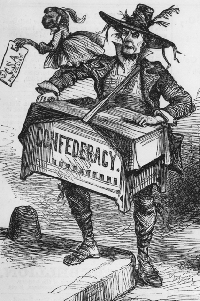
![]()
Notes for Using Archival Materials
Using original materials can be one of the great joys of scholarship. The material culture of an era comes to life when one handles an artifact, be that a book, newspaper, or other object. Unless a reader exercises some care, however, these materials can be lost. Many newspapers and magazines were printed on high-acid paper that makes them vulnerable to sunlight, temperature changes, even the oil on a human fingertip! For these reasons, archivists can be very particular about how patrons handle certain library materials. If you have a choice, use a microfilm copy of an original item. This preserves the original item for posterity.
Many journals and newspapers
have been copied to microfilm. This format makes for speedy access,
but microfilm can be difficult to read and even more difficult
to copy. Moreover, the economics of copying rarely used materials
can make storage of originals preferable to microfilming or digitizing
copies. At some point, anyone doing original research will want
to consult original materials in the collections on campus and
at the Library of Virginia. When doing this, remember these guidelines:

- Read any policies for the institution. They will vary!
- Carry a pencil (not a pen) and pad with you. You will probably also be able to carry a laptop, but you may not be allowed to carry other loose papers or books into an area where archival materials will be available.
- If an original item is very fragile, please ask for help. Libraries often provide cotton gloves for researchers using their archives.
- Carry some quarters for the lockers at Library of Virginia. You cannot bring book-bags into the Archives reading room, and you will want to securre any other research materials nearby.
Main
Page | Reading & Class Schedule
| Midterm Essay | Seminar
Paper